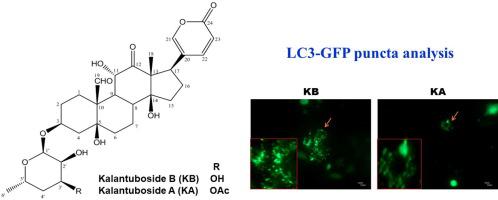Bioorganic & Medicinal Chemistry Letters ( IF 2.7 ) Pub Date : 2020-11-25 , DOI: 10.1016/j.bmcl.2020.127715 Hui-Chi Huang , Wen-Te Chang , Meng-Shiou Lee , Hsing-Yu Chen , Yu-Hua Chen , Chi-Chen Lin , Ming-Kuem Lin

|
The effects of 3 bufadienolides, namely kalantuboside B, kalantuboside A, and bryotoxin C, isolated from Kalanchoe tubiflora (Harvey) were evaluated and characterized in CL1-5 highly metastatic human lung cancer cells. In contrast to their apoptosis-promoting activity in other cancer cells, these bufadienolides only slight or did not induce apoptosis in CL1-5 cancer cells. Instead, they activated an autophagy pathway, as indicated by increased autophagosome formation. Autophagy induced by these bufadienolides was demonstrated to be linked to the down-regulation of p-mTOR and the up-regulation of LC3-II, ATG5, ATG7, and Beclin-1. Our findings revealed an autophagy as the alternative mechanism of drug action by bufadienolides in CL1-5 lung cancer cells and provided evidence that bufadienolides are a potential therapeutic strategy for highly metastatic human lung cancer.
中文翻译:

三种bufadienolides主要通过自噬诱导人肺癌细胞CL1-5的细胞死亡
的3个bufadienolides,即kalantuboside B,kalantuboside A,和bryotoxin C,从分离效果长寿tubiflora(Harvey)在CL1-5高转移性人类肺癌细胞中进行了评估和表征。与它们在其他癌细胞中促进凋亡的活性相反,这些丁二烯内酯在CL1-5癌细胞中仅诱导或不诱导凋亡。相反,它们激活了自噬途径,如自噬体形成增加所表明。这些bufadienolides诱导的自噬被证明与p-mTOR的下调和LC3-II,ATG5,ATG7和Beclin-1的上调有关。我们的发现揭示了自噬是布法地那利德在CL1-5肺癌细胞中替代药物作用的机制,并提供了证据表明布法地那利德是高度转移性人类肺癌的潜在治疗策略。



























 京公网安备 11010802027423号
京公网安备 11010802027423号